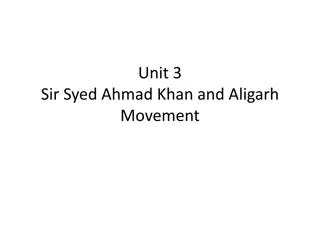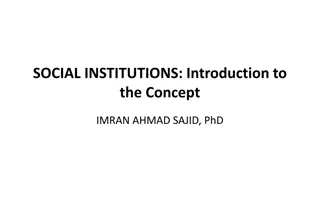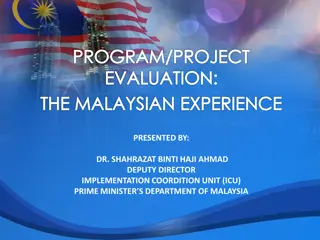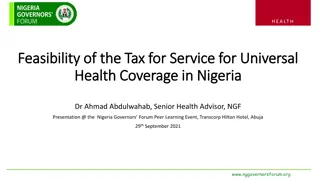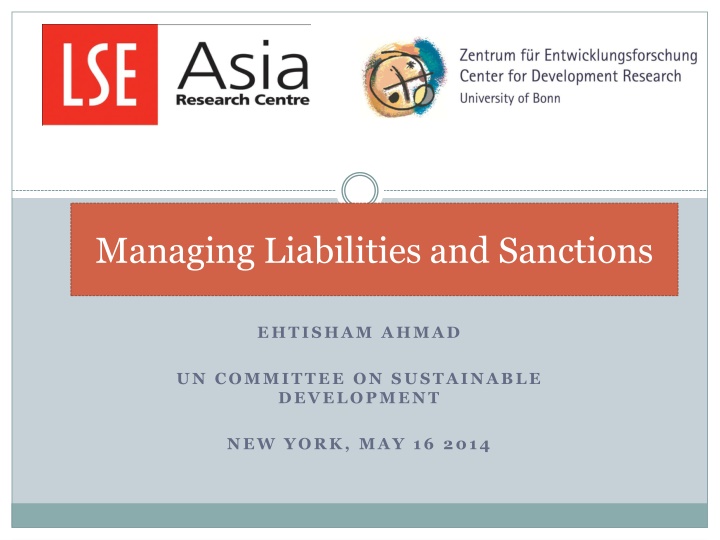
Managing Liabilities and Sanctions in Sustainable Development Context
Explore the importance of managing liabilities and sanctions in sustainable development, discussing why debt is necessary and how to handle it effectively. Delve into the complexities of hidden liabilities, financial accountability, and the challenges faced in addressing liabilities for sustainable growth.
Download Presentation

Please find below an Image/Link to download the presentation.
The content on the website is provided AS IS for your information and personal use only. It may not be sold, licensed, or shared on other websites without obtaining consent from the author. If you encounter any issues during the download, it is possible that the publisher has removed the file from their server.
You are allowed to download the files provided on this website for personal or commercial use, subject to the condition that they are used lawfully. All files are the property of their respective owners.
The content on the website is provided AS IS for your information and personal use only. It may not be sold, licensed, or shared on other websites without obtaining consent from the author.
E N D
Presentation Transcript
Managing Liabilities and Sanctions EHTISHAM AHMAD UN COMMITTEE ON SUSTAINABLE DEVELOPMENT NEW YORK, MAY 16 2014
Why debt? And How to manage it? 2 Debt needed to spread costs across generations: Needed investments sustainable growth; climate change; ageing of the population; lagging regions (E. L nder) Income growth may involve tradeoffs between redistribution with growth hubs and labour market mobility (China) Leads to potential game-play Imperfect information makes things more complex Game play encouraged in some cases, outright cheating, inefficiency
Generation of liabilities and sustainable growth 3 Finance with Accountability? For effective provision of basic services (minimum standards whose?) Interactions with revenues own-source revenues needed for accountability and access to credit Access to credit: markets need signals that 1 of debt in Munich is equal to 1 of debt in Madeira Appropriate institutions and information flows (Ahmad, G24, 2014) Risks associated with infrastructure gaps, PPPs and involving the private sector Special focus on PPPs (UN Sustainable Development Agenda Ahmad, Bhattacharya, Vinella, Xiao) Investments for the ageing; climate change; sustainable growth in lagging regions
A typical problemhidden liabilities Madeira 2011 4 Portugal in the middle of a severe crisis, under the Troika Where did the liabilities arise from, and why were they not known? 1.1 bn not declared Disagreement over whose responsibilities Pharmacies 67m Health System 42m Construction Cos 690m Other suppliers 290m Total debt: 127% of GDP; 927% of annual revenues; 47% in SOEs
Source: Manuela Paixo and Rui Balieras CFP Occasional Paper 01/2013 5
Can Medeira under- take the adjust- ment? 6
In general. 7 Can a system of sanctions work with limited information? Same problem with Portuguese municipalities, indeed the Central Government although some progress EU situation more complicated: Ireland and Spain Private liabilities become public liability through the Banking System
Response by the Fiscal Council 8 Cardoso, von Hagen, Baleiras, Kopits, Marinhero (April 2013) Avoid manipulation of data Combination of rules to make it functional, but not too complex to make it un-implementatble 1. Budget coverage needs to be inclusive 2. Proper accounting procedures, including PPPs 3. Relevant COA (was required in 2007 with two years grace, but not done) what chance now? What standards? 4. TSA to track the cash 1. 2.
Brazilevolution of FRL? 9 Tighter limits due to FRL (2000) Accompanied by uniform budget standards and tracking of the cash: TSA Initial success But, states move to own GFMISs, tracking and reporting Possibility of game-play Fiscal rules now giving way to Administrative controls ?
Germany 10 Policy at the Federal level, admin at the L nder (absence of own-source revenues a problem for accountability; national policies) Issues related to standard budget operations across the SNGs Potentially better market information, but still scope for game-play Will debt-break make for more obfuscation of information? Spahn (2014) feels that this is likely Otherwise there may be a contradiction with the uniform standards criterion Perhaps a full review of the IGFR is needed (failed Federalismus I und II)?
Sanctions with various mechanisms 11 NEED FULL INFORMATION, ELSE GAME-PLAY POSSIBLE
Various mechanisms 12 Market discipline Clearly need the standardized information to be able to function Else, will make mistakes Leaving to market may not be politically feasible (e.g., minimum standards), hence sanction not always credible Sanctions preconditions Markets must be able to operate freely Information on liabilities and ability to pay must be available Is no bailout credible? Are there adequate institutions to ensure adjustments?
Other mechanisms and constraintsinformation is critical in each case 13 Cooperative arrangements Will only work if jurisdictions do not cheat Problems with minimum standards; expectations that exceed resources (rich regions, lagging regions) Fiscal rules Need the information as well (Madeira, Ireland, Greece) Tighter sanctions (including individual liability), new games on the GFMIS systems? Administrative arrangements Not immune to game-play
Governance and Institutions 14 IMPERFECT INFORMATION LEADS TO GAME PLAY ACROSS LEVELS OF GOVERNMENT; AND WITH FIRMS
Imperfect information, Game-play and Political economy 15 Imperfect information Leads to game play across levels of government And between government and private contractors (leverage to re- contract, especially in high profile cases) Hiding or non-recognition of liabilities In extreme cases, private debt could result in public assumption of the liabilities Ireland and Spain, recent crisis; and Mexican roads in the 90s Could result in poor decision making and cost- overruns
Credibility of the State and Accountability 16 Follow spending by all levels of government Institutions, economic classification, functions, projects, programs, outputs and outcomes Manage liabilities Track using common standards: lesson from EU failures Essential to know what was spent by each level, before ascribing results to local participatory or performance budgeting in countries with overlapping responsibilities, earmarking Essential also to know extent of liabilities (also securitization of revenues, with single term mayors) Plus track the cash, to prevent cheating and leakages Harder to address clientelism , although capture is easier to detect
PPPskicking the can down the road? 18 Very easy to use as a means of postponing reckoning and avoiding debt limits Pass the buck also to future administrations Also other jurisdictions The Center carries the can if there are no own-source revenues After European crisis tightening of IPSAS rules Who owns the assets? should guide provisioning Resisted in EU, as it would add to deficits and debt
PPPsa Few Policy Implications 19 Reliable Third Party and Separation of Powers Critical in establishing the sanctity of contracts Tightening the definitions of PPP liabilities This is to prevent a fiscal kicking the can down the road, and prevention of macroeconomic crises Minimizing the risk of government default Government Budget Implications Need for recognition of the liabilities being generated and the associated provisioning (new IPSAS rules)
Credibility and Risk Mitigation 20 Impartial arbiters between firms and governments Incentives to renege and renegotiate contracts Asymmetric information Political power with high profile projects (possible rent seeking as well) Governments also cannot be trusted without adequate own-source revenues Scope for a new multilateral agency to do this?
Incentives and transfer design 21 Central transfers in spheres of sub-national jurisdiction have a debilitating effect Badly design equalization systems or gap filling can negate the incentives to use own-source revenues In effect can lead to poor investment decisions, and build-up of unproductive assets and liabilities It s all about incentives and the interactions between instruments Information is critical GFSM2001 standards not for reporting to IMF but for domestic management of liabilities Big projects in Egypt: PR China; Saudi Arabia; needed elsewhere including in Europe .
GFSM2001 methodology for all levels of government, linked to SNA Transactions uses specific codes to identify economic flows and stocks 1 Revenue 2 Other Economic Flows Stocks Expense 4 5 6 3 Transactions in Non financial assets Holding gains/ losses: nonfinancial assets, financial assets, liabilities Other volume changes: nonfinancial assets, financial assets, liabilities Nonfinancial assets, financial assets, liabilities Transactions in financial assets & liabilities by instrument 7 Functions 8 Transactions in Financial Assets & Liabilities by sector
Chart Of Accounts (COA) 23 Logical framework for recording and reporting financial information Modern systems include GFSM2001 fully in COA Accommodate progressive move to accrual accounting Program and performance budgeting Asset and liability accounts in addition to revenue and expense accounts Forms core of the information to be generated and tracked in a GFMISs Must be common across levels of government Not always followed, with great difficulty in tracking spending or liabilities Can be quite problematic
Chart of Accounts (COA) - Segments No. Segment 1. Institutional Entity Size 2 Description Economic Entity e.g. General Government Sector, Other Economic Entities 2. 3. 4. Source of Funds Functional Classification Administrative Classification 2 8 6 Funding Sources UN/OECD COFOG Ministries, departments, agecies 5. Program / Sub Program Classification Activities / Projects Geographic Economic Classification 6 Outcomes 6. 7. 8. 6 6 8 Achieving Outputs Region, District GFSM2001 Revenue, Expense, Assets and Liabilities 9. Spare 6 Including for possible performance indicators/Outputs 24
Preconditions for effective management of sub- national liabilities 25 Need information to make the process more transparent and accountable Better linked to local priorities Avoid exclusive emphasis on physical infrastructure Balanced with o/m and human capital needs Essential to have own-source revenues at margin; ensure hard-budget constraints Moves to provide information to market, as well as monitoring at center essential Ratings agencies Could be done in asymmetric manner
Important to track the cash. 26 TSA? with? donors/local? government? Chart$ 1,$ Local$ government$ and$ donor$ use$ of$ correspondent$ accounts$ linked$ to$ TSA$ MOF$ Informa; on$ flo s$ Payment$ request$ C/A$ 2$ w C/A$ $ 1$ Payee$ Payment$ Order$ ZBA$ Payment$ request$ Payment$ 38? Source: Ahmad (2013, 2014)
Spending can be managed with a decentralized GFMIS infrastructure if the COA is common 27 As with the tax administration, a common infrastructure can be used (both for the TSA as well as GFMIS) Replicated at the regional level With local administrations using on an agency basis Decentralized spending can be tracked/ GFMIS But a common data base is critical Essential ingredient is the COA Mappings to the GFSM2001 are not adequate (commonly used, e.g., in Latin America)







